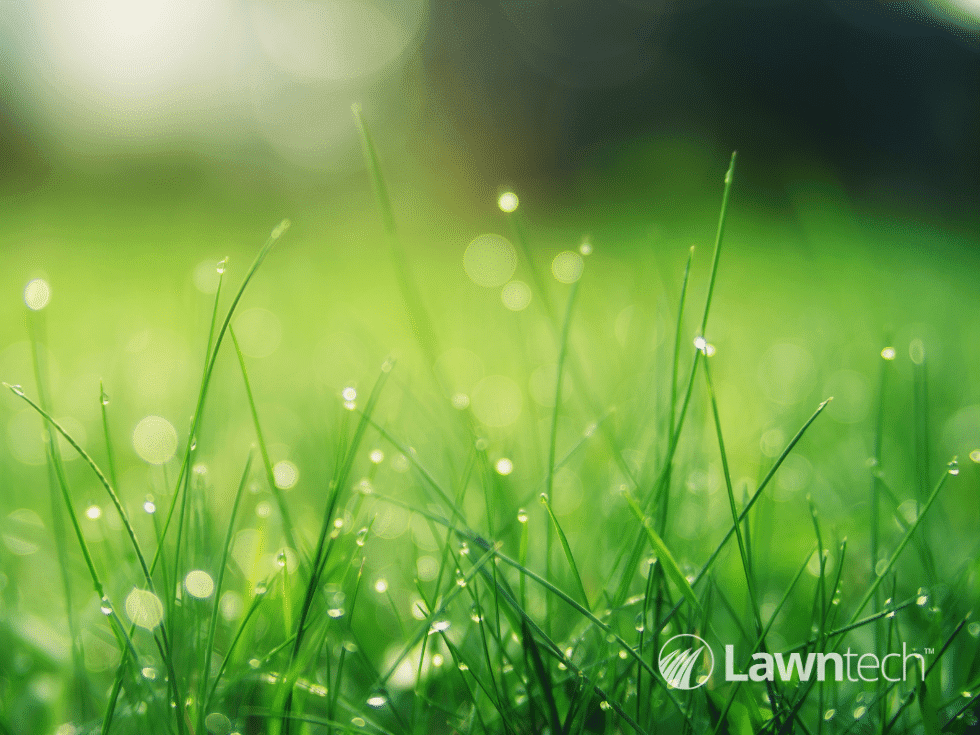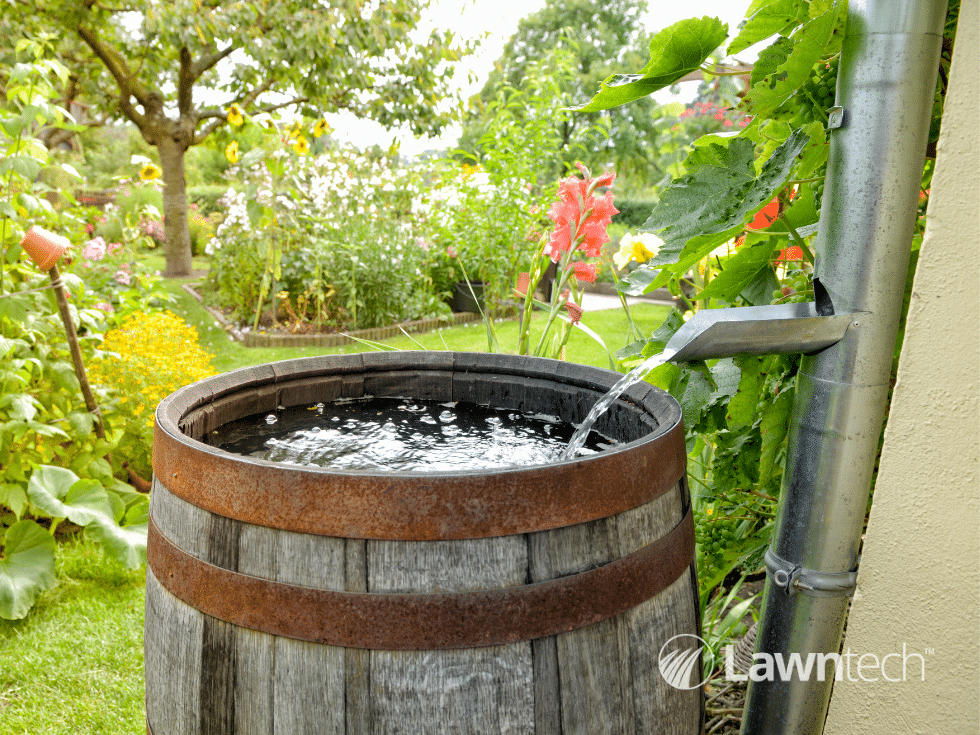Don’t rain on my parade – just on my roof…
The only certain way to ensure rain is to wash the car, break out the BBQ or give the garden a watering…
As we head into June after a long, wet May it looks like we’re in for a prolonged spell of warm, dry weather. It might be a good time to think about harvesting valuable rainwater when it does come back, for use on a non rainy day!
It’s clear that people have been adopting more environmentally-conscious landscaping ideas over recent years, and one of the most common trends is the collection of rainwater. Every summer, outdoor garden activities (and prinicipally, lawn watering) typically require about 40% of a household’s water use – which is extraordinary, when you think about it. In addition, the rise in our water bills can certainly become noticeable, which is why many more people are turning to collecting rainwater to reuse and therefore minimize wastage from runoff.

Natural rainwater for your lawn. There’s nothing like it.
What Are The Benefits Of Rainwater Collection?
- Rainwater is a free source of water
- It is environmentally responsible, promotes self-sufficiency and helps conserve water
- Rainwater is better for landscape plants and gardens because it is not chlorinated
- It uses simple technologies that are inexpensive and easy to maintain
What Are The Uses Of Collected Rainwater?
- You can essentially use rainwater anywhere you use garden tap water
- Rainwater collection is a technique to ‘green your home’ and to lessen your environmental footprint
- Water your lawn and garden or connect your collection system to an irrigation or sprinkler system
- Refill your fish ponds and use rainwater to wash your car or driveway
We particularly love the idea of using your harvested water in a solar powered water feature. It’s a recycling double whammy – rain and sun.

Solar powered water features which recycle rainwater offer an ecological double whammy.
There are lots of options out there, but a few places you may like to check out are:
www.powerbee.co.uk/solar-water-features.html
www.outdoorlivinguk.co.uk/solar-water-features.html
www.primrose.co.uk/solar-water-features-c-1_108.html
Just How Much Rain Can I Collect?
- The amount of rainfall that you can collect is governed by the following formula: 1″ of rain x 1 sq. ft. = 0.623 gallons. Therefore 1″ of rainfall over 1,000 sq ft will yield 623 gallons. That’s 2,832 litres!
- To calculate the amount of rainwater you can collect, you need to know the annual average precipitation for your area. You can use online precipitation maps to find an approximate amount for this
- Some trade sites have calculators that allow you to work out how much you might be able to collect
Is Collecting Rainwater legal In The UK?
This may sound an odd question, but scaremongering stories from abroad have concerned Brits regarding the legality (or otherwise) of rainwater harvesting. Luckily it is perfectly legal and actually encouraged by most water companies in the UK, especially in the drier southern counties where rainfall is lower than it is along the west coast.
Although there’s nothing to prevent you collecting rainwater, there are standards and regulations that apply. These are mainly for large projects ie: if a cross-connection is made to the mains water supply, but worth checking before you start anything significant. Naturally there are regulations concerning the supply of drinking water, but again, these are almost always for developers or larger projects.
- Water Regulations Advisory Scheme (WRAS) – see the official WRAS website for more information
- BS 8515:2009 Rainwater Harvesting Systems – Code of Practice
- Planning Permission – “permitted development” rights (includes rainwater harvesting systems)
- Pipe Marking – harvested rainwater must be labelled as non-potable
*relevant at time of writing

Collecting rainwater via your guttering and a good old barrel. The old school way.
Rain Barrels (or butts)
This method is the most common and one that many people are familiar with, which involves installing a barrel at a gutter downspout to collect rainwater. The actual barrel may be new or recycled but is typically 55-gallon food-grade plastic. Alternatively they can be made from materials like glazed ceramic or wood. If your doesn’t run to a new rain barrel or large decorative vessel, you can utilise an old bin or other large container and disguise it. As long as it holds water it’ll work! You can buy covers or get creative yourself – think about using old wood planks, bamboo screening, rope, sisal matting or good old-fashioned paint.
- Pros: Easily implemented, barrels are readily available, don’t take up much space so they can fit into any situation
- Cons: Capacity is generally only 50 to 100 gallons, easily overflows and wastes collection opportunities
“Dry” System
A variation on a rain barrel set-up, but it involves a larger storage volume. Essentially, the collection pipe “drys” after each rain event since it empties directly into the top of the tank.
- Pros: Can store a large amount of rainwater, can be inexpensive to implement, less complicated system so maintenance is easier
- Cons: The storage tank must be located next to your house
“Wet” System
This method involves locating the collection pipes underground in order to connect multiple downspouts from different gutters. The rainwater will fill the underground piping and the water will rise in the vertical pipes until it spills into the tank. The downspouts and underground collection piping must have water-tight connections. The elevation of the tank inlet must be below the lowest gutter on the house.
- Pros: The ability to collect from your entire collection surface, collect from multiple gutters and downspouts, tank can be located away from your house
- Cons: More expensive to implement due to underground piping
Rain chains
Rain chains are a more decorative alternative to traditional metal or plastic downspouts, and come in a wide variety of styles. Essentially they all have the same purpose of directing rainwater from your roof gutters to the ground or into a storage vessel. Rain chains (“kusari-doi”/“chain gutter”), originated in Japan in the 1600s and have adorned houses and temples for hundreds of years. Rain chains began gaining international popularity after Japan hosted the 1998 Winter Olympics and visiting style connoisseurs spotted them. The more recent popularity might also be down to the Cobra Kai TV series…
Many shops and online retailers carry rain chains, but they’re also simple to make at home. Different objects from plant pots, industrial chain, cutlery, stones and other recycled household items can be put to use – as long as it forms a continuous, gravitational ‘flow’ it will do the job! The BBC TV series Garden Rescue has also been known to feature rain chains, with the presenters making them from scratch.
THE ULTIMATE SOLUTION – Underground tanks
Unfortunately, the sad truth is that however many barrels or butts we use to harvest rainwater from the roofs of our homes, garages and sheds, we can never hope to collect and store enough to water our lawns. A terrible shame when you consider how much rain we have here in the UK!
There is a solution available though, if you are prepared to invest in an underground rainwater harvesting system. This opens up all sorts of possibilities including automated irrigation for your lawn and garden.
Harvesting the rainwater
Rainwater is collected either via the downpipes of your guttering or the property’s underground stormwater drainage pipes. In both cases, the water is filtered and this can be done to a very fine degree. Preferably this filtering mesh should be less than 1mm or 1000 microns to ensure the minimum of debris reaching the tank. Leaf guards are also available, for those properties which are surrounded by a lot of trees.
The tank itself
Usually a one-piece design, and is normally constructed from either high density polyethylene or GRP (Fibreglass). It is usually buried up to 1.2 metres under the ground and encased in either compacted stone or concrete. The tank is accessed from the ground via an inspection cover for maintenance purposes, though in most cases, once an underground tank is installed it needs very little human interference. The tanks usually include an emergency mains water inlet and float switch, to make sure that the tank never runs dry and protect the pump which drives the water on to the irrigation pipes. This pump can be operated on demand or controlled by a timer. Many of these systems are highly sophisticated, offering fine monitoring and control over the tank and its precious contents.
These systems can be highly effective in helping to recycle rainwater for uses way above and beyond the lawn or garden. A pressurised outlet pipe can take the water from the underground tank not only to an outside tap but inside the home too. Here it can be used by any of your domestic appliances and WCs.
If you’d like more information on harvesting rainwater, why not visit https://www.rainharvesting.co.uk/
For advice on irrigation systems for your lawn, try http://www.waterscapesolutions.co.uk/
For advice on dealing with a lack of water, we already have a number of informative blog posts covering topics such as:
- Droughts & watering your lawn
- The golden rules when watering your lawn
- How to maintain your lawn during dry weather
- How to look after a dry, brown lawn
- Preparing your lawn for the Summer
- How much does it cost to water your lawn?
All of these posts, and more, can be found on our online Lawn Blog:
https://www.lawn-tech.co.uk/blog
We also have our own Watering Cost Calculator, so you can see how much money you can save by recycling the rainwater you collect. You can find it right here, on our website…



